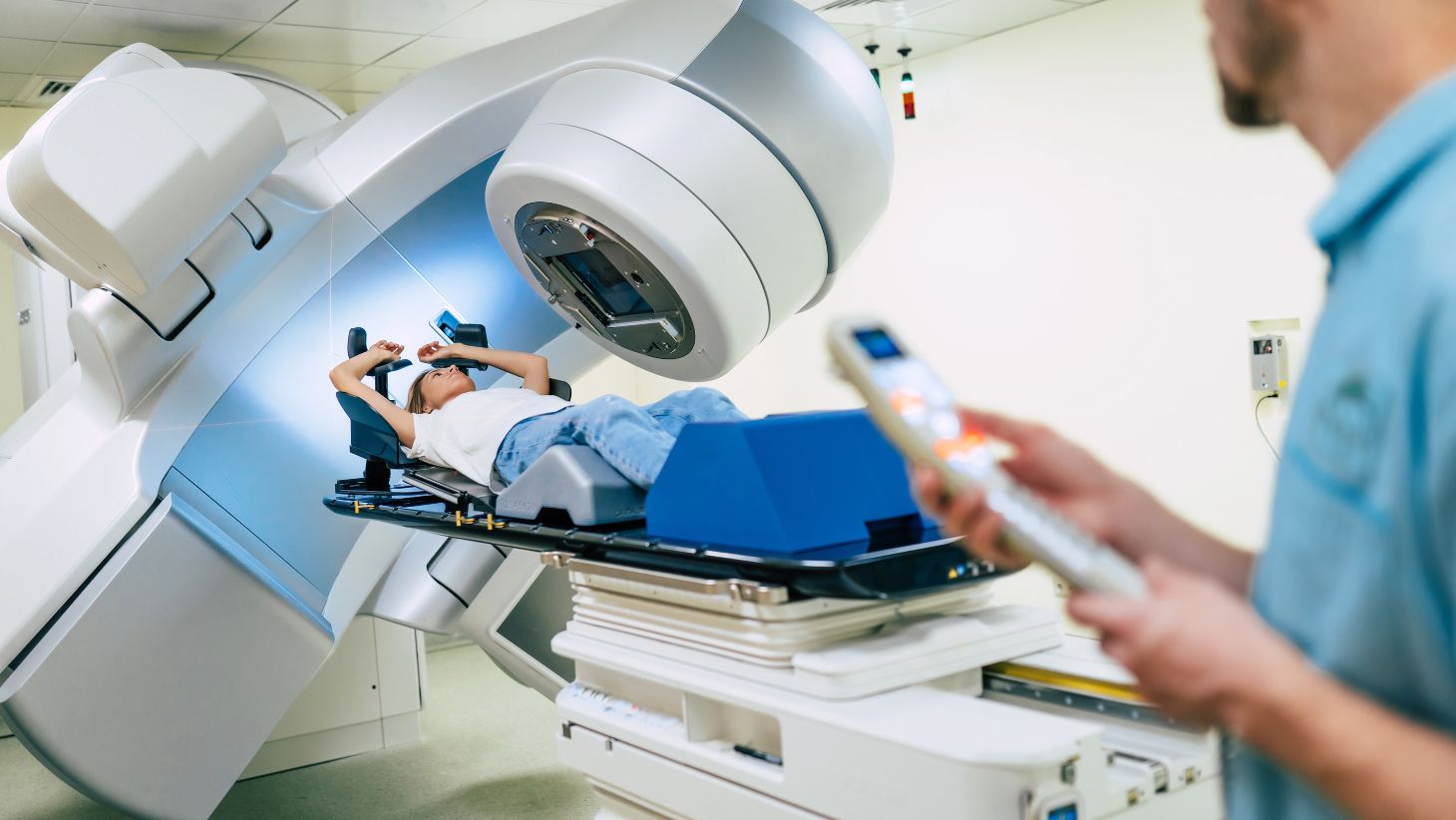Radiation therapy (or radiotherapy) is a common treatment method for cancer, useful for about 60% of all cancers. New treatment methods and updates to the amount of radiation given have improved the accuracy and success of radiation therapy for cancer treatment. Learn about why oncologists include radiation therapy in the treatment process and discuss the side effects of radiation therapy for cancer treatment.
How Radiation Therapy Works
The most commonly used radiotherapy is external beam radiation therapy. This uses high-energy waves to target cancerous cells and shrink tumors. Radiation stops your cells’ ability to divide and grow. When the cells try to divide but cannot, they die, and the tumor shrinks.
Cancer cells keep dying for months and divide more slowly after radiation therapy ends. Even if a tumor begins to grow again after treatment ends, it usually grows at a slower rate than it did initially. Radiation is often used with surgery and/or chemotherapy to prevent cancer from returning.
One session of radiation treatment usually lasts about 15-30 minutes, and most patients have five treatments per week. Anywhere from four to nine weeks of treatment is the normal timeframe for treatment. This will depend on whether the radiation therapy is hypofractionated.
What is Hypofractionated Radiation Therapy?
Hypofractionated radiation therapy is a new method used to deliver higher doses of radiation therapy at each treatment session. It’s becoming more widely used because it shortens the overall treatment duration.
Patients appreciate having fewer treatment appointments at less cost. There is no difference in the quality, safety, and effectiveness of cancer therapy when comparing standard radiation therapy to hypofractionated therapy methods.
Instead of receiving radiotherapy for 6 - 8 weeks, the same treatment can be achieved in 4-5 weeks by giving a higher dose of radiation at each treatment. The specific number of treatments depends on the cancer's location, its size, and each patient’s general health. Hypofractionated radiation therapy is currently used most often for breast, lung, and prostate cancers.
When is Radiation Therapy Used in the Cancer Treatment Process?
An essential benefit of radiation therapy for cancer treatment is its versatility. It may be used as the only treatment needed for some cancers, before surgery to shrink a tumor, after surgery to kill remaining cancer cells, or in combination with chemotherapy. Radiotherapy is also used to reduce cancer symptoms.
Radiation therapy can treat most types of cancer, including cancer of the blood, bone, brain, breast, cervix, colon, esophagus, eye, head and neck, liver, lung, prostate, thyroid, and others.
Radiation therapy technology continues to improve the precision of targeting cancer cells, but it also can affect surrounding healthy tissue. Normal tissue repairs itself by rapidly building up more cells through rapid cell division.
Types of Radiation Therapy
Radiation therapy for cancer is delivered externally or internally.
External Radiation Therapy
External radiation is the most common method and uses a machine outside your body to deliver high-energy beams to the tumor. Types of external radiation include:
- Three-dimensional conformal radiation therapy (3-D-CRT) uses 3-D images of cancer created from CT, or MRI scans to guide the radiation precisely. This permits a higher dose, less damage to healthy tissue, and fewer side effects.
- Intensity-modulated radiation therapy (IMRT) permits the intensity of the radiation to be varied to target the tumor better and cause less damage to healthy tissue.
- Image-guided radiation therapy (IGRT) uses images taken before and during treatment to target the radiation at the tumor.
- Stereotactic radiation therapy (SRT) uses a large, precise radiation dose. It’s usually given in one to 10 treatments.
Internal Radiation Therapy
Internal radiation (or brachytherapy) uses a radioactive pellet or seed placed inside the tumor or surrounding area. The seed releases radioactive particles that kill cancer cells. Implantation may require a hospital stay and anesthesia. Systemic radiation is delivered by chemicals given by mouth or into the blood via an IV injection.
Types of internal radiation include:
- Permanent radiation implants containing radioactive particles are implanted into the tumor. About the size of a grain of rice, the implants deliver radiation around the implant area and gradually lose their radioactivity. During treatment, other people must be protected from the radiation that escapes the patient’s body. This is also referred to as low-dose brachytherapy.
- Temporary internal radiation therapy can be administered via a needle through a catheter or internal applicator. The radiation stays in the body for a few minutes, up to a few days. This is also referred to as high-dose-rate (HDR) brachytherapy.
Other Radiation Therapy Options:
- Intraoperative radiation therapy (IORT) delivers radiation during surgery, either externally or internally. IORT is most effective in treating cancer close to a vital organ.
- Radioimmunotherapy uses monoclonal antibodies that are attracted to markers on cancer cells. They can precisely deliver radiation directly to a tumor and spare healthy tissue nearby.
Advantages of Radiation Therapy
The benefits of having radiation to treat cancer include:
- Highly effective at killing the majority of cancer cells inside a tumor. It may be the only treatment needed for small tumors and early-stage cancers.
- It kills isolated cancer cells that surgery could not detect.
- Shrinks tumors to make surgical removal more effective. Shrinking tumors with radiation can make surgery possible for formerly inoperable tumors.
- High level of patient safety.
- Treatment is painless.
- When combined with other treatments such as chemotherapy, radiation becomes more successful and makes chemotherapy more successful than either method is when used alone.
- Reduces cancer symptoms.
- Increases quality of life by preventing organ removals, such as a breast or part of the digestive tract.
- Radiation may stimulate the body to develop an immune response to the tumor.
Is There a Downside to Using Radiation Therapy?
Although radiation therapy has saved the lives of countless cancer patients, it’s not ideal for every patient. There are also some side effects, although they usually go away after treatments end.
- Surrounding healthy tissue or organs can be damaged, depending on their location to the tumor. This is usually what leads to side effects.
- Radiation therapy can only be used on tumors that are visible on a CT image. Sometimes a PET scan will show spots where cancer is developing but not yet visible. Those will usually be treated with a systemic drug like chemotherapy.
- Lower effectiveness in killing all cancer cells in large tumors.
- Radiation is less effective in killing cancer cells in areas with poor blood supply because it reduces oxygen to the tumor area.
- Not an option if the patient has previously had radiation to the same area or has certain disorders.
Side Effects of Radiation Therapy
Because radiation treatment also affects healthy cells, it can cause side effects. They depend on the type of cancer, its stage and location, and the amount of radiation you have. Some patients don’t have side effects. It’s unusual to have more than a few of the following side effects. Most of them go away after treatment is complete.
- Fatigue – partly due to the energy your body needs to replace normal cells killed during treatment.
- Changes in the skin over the treatment area, including soreness, redness, or peeling.
- Depending on the cancer’s location, these side effects can occur:
- nausea
- vomiting
- diarrhea
- dry mouth
- sore throat
- cough
- breathing difficulties
- swallowing problems, or
- hair loss over the treatment area.
- The development of a second cancer is rare, but the risk is higher for older people or those with specific types of cancer.
Access to the Newest Radiation Therapy Treatments at Willamette Valley
The radiation oncologists at Willamette Valley Cancer Institute (WVCI) are highly skilled and experienced in the newest radiotherapy technology. They’ll take the time to understand your cancer diagnosis and work with you to consider all treatment options to create an effective and safe treatment plan. WVCI has cancer treatment centers in Albany, Corvallis, Eugene, Florence, Lincoln City, and Newport, Oregon. Find a location near you to request an appointment.




